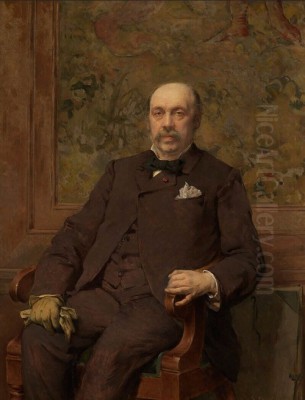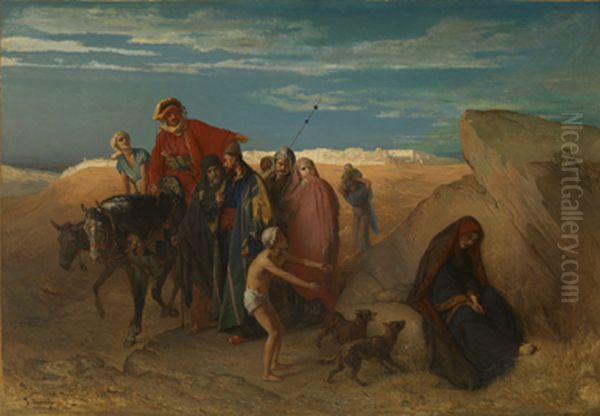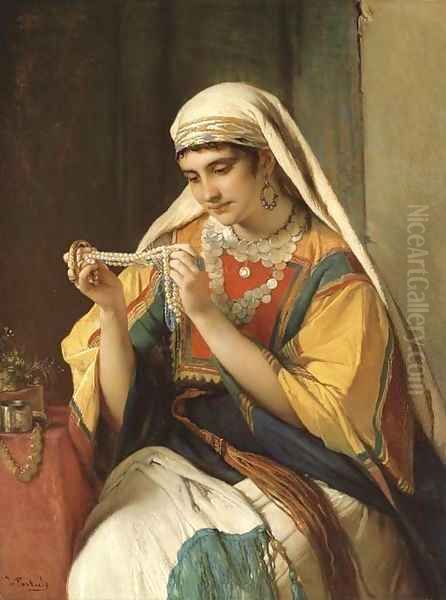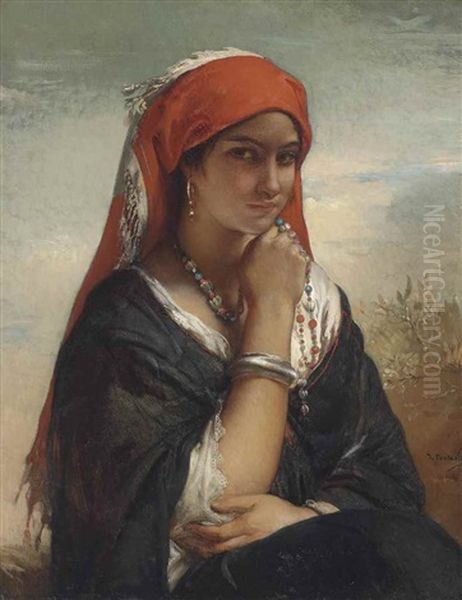Introduction: A Defining Figure in Belgian Art

Jean-François Portaels stands as a pivotal figure in 19th-century Belgian art. Born on April 3, 1818, in Vilvoorde, Belgium, and passing away on February 8, 1895, in Saint-Josse-ten-Noode, Brussels, his life spanned a period of significant artistic evolution. Portaels is primarily celebrated as the founder and leading proponent of the Belgian Orientalist school, bringing vivid depictions of the Near East and North Africa to a European audience. Beyond his own prolific output, he was a highly influential teacher and administrator, shaping a generation of artists as a professor and later Director of the prestigious Académie Royale des Beaux-Arts in Brussels. His work skillfully blended academic precision with the allure of exotic locales, securing his legacy as both a master technician and a captivating storyteller.
Early Life and Academic Foundations
Portaels' artistic journey began with formal training at the Académie Royale des Beaux-Arts in Brussels. Here, he came under the tutelage of François-Joseph Navez, a prominent Belgian Neoclassical painter who had himself studied under the great Jacques-Louis David. Navez's influence was profound, instilling in Portaels a strong foundation in drawing, composition, and the academic tradition. The relationship deepened over time, with Portaels not only becoming Navez's star pupil but eventually also his son-in-law, marrying Marie-Hélène Navez in 1849. This familial connection further solidified his ties to the established art world of Brussels.
Seeking broader horizons, Portaels also spent time in Paris, the undisputed center of the European art world. There, he studied with Paul Delaroche, a renowned French painter known for his historical scenes, often executed with dramatic flair and meticulous detail. Exposure to Delaroche's style likely broadened Portaels' thematic interests and refined his narrative abilities, complementing the Neoclassical rigor inherited from Navez. This combination of Belgian and French academic training provided Portaels with a formidable technical skillset upon which to build his career.
The Prix de Rome and Transformative Travels

A crucial turning point in Portaels' career came in 1842 when he won the prestigious Grand Prix de Rome for Belgium. This highly coveted award provided laureates with funding for an extended period of study and travel, traditionally centered on Italy and the classical world. Portaels embraced this opportunity wholeheartedly, embarking on extensive journeys that would fundamentally shape his artistic vision. While he visited Italy, absorbing the lessons of the Renaissance and classical antiquity, his wanderlust took him far beyond the traditional itinerary.
His travels extended across the Mediterranean and into the Near East and North Africa. Over several years, he visited Spain, Morocco, Algeria, Egypt, Lebanon, Judea, Greece, Hungary, and Norway. These voyages were not mere sightseeing tours; they were immersive experiences. Portaels sketched prolifically, observed local customs, collected artifacts, and absorbed the unique light, colors, and atmospheres of these diverse regions. This direct contact with non-European cultures provided the authentic source material that would fuel his lifelong engagement with Orientalist themes. The sketches and studies gathered during these years became an invaluable resource, informing his paintings for decades to come.
The Essence of Portaels' Orientalism
Returning to Belgium, Portaels channeled his travel experiences into his art, quickly establishing himself as the leading figure of Belgian Orientalism. His style was characterized by a fascination with the "Orient"—a term then used broadly to encompass North Africa, the Middle East, and parts of Asia. He depicted bustling marketplaces, serene domestic interiors, religious ceremonies, and striking portraits of individuals in traditional attire. His works captured the perceived exoticism, mystery, and sensuality associated with these regions in the 19th-century European imagination.
Portaels' Orientalism was marked by several key characteristics. He possessed a keen eye for ethnographic detail, rendering costumes, architecture, and objects with considerable accuracy, based on his firsthand observations. His compositions, while rooted in academic principles of balance and clarity, often incorporated dynamic arrangements and dramatic lighting. He was particularly praised for his depiction of elegant female figures, often portrayed with a refined sensuality and psychological depth, earning him the moniker "painter of everyday and feminine grace." His color palette was rich and evocative, capturing the intense light and vibrant hues he had encountered during his travels.
Blending Academicism and Romanticism

Artistically, Portaels navigated a path between the established norms of Academicism and the burgeoning sensibilities of Romanticism. His rigorous training under Navez and Delaroche ensured his work always maintained a high degree of technical finish, precise drawing, and carefully structured composition – hallmarks of the academic tradition. He excelled at rendering textures, from shimmering silks and intricate jewelry to sun-baked stone and human flesh. This technical mastery lent credibility and visual appeal to his depictions of faraway lands.
However, Portaels infused his academic framework with Romantic elements. The choice of exotic subject matter itself aligned with Romanticism's fascination with the distant, the unusual, and the emotionally charged. His paintings often conveyed a sense of atmosphere, mood, and narrative intrigue that went beyond mere ethnographic documentation. The use of dramatic light and shadow (chiaroscuro) added emotional intensity, while the focus on individual characters and their implied stories invited viewers to engage imaginatively with the scenes presented. This synthesis of academic discipline and romantic sensibility proved highly successful and popular.
Key Orientalist Works
Several paintings stand out as representative of Portaels' Orientalist oeuvre. The Daughter of Zion, also sometimes referred to in relation to biblical themes, likely depicts a poignant scene drawn from religious texts but set within an Orientalist context, showcasing his ability to blend historical narrative with exotic settings. The Pearl Necklace is another significant work, likely focusing on the theme of feminine beauty and adornment within an Eastern interior, highlighting his skill in rendering textures and creating an intimate atmosphere.
His painting Esther (1869) tackles a biblical subject, Queen Esther, but frames her within the opulent visual language of Orientalism. Such works reflect the 19th-century trend of re-imagining biblical narratives through an Orientalist lens, emphasizing the historical setting's connection to the Near East. Works like Boudaïnou, likely depicting a specific location or figure encountered during his North African travels, exemplify his commitment to capturing the particularity of place and culture. These paintings, among many others, cemented his reputation and brought the visual world of the "Orient" into Belgian homes and galleries.
A Leading Educator: The Académie and the Atelier Libre
Portaels' influence extended far beyond his own canvases. He was deeply committed to art education and held significant academic positions. From 1847 to 1849, he served as the Director of the Academy of Fine Arts in Ghent. Upon returning to Brussels permanently, his stature grew. He became a highly respected professor at the Académie Royale des Beaux-Arts in Brussels, the very institution where he had trained. His success and influence culminated in his appointment as Director of the Brussels Academy in 1878, a position he held for many years.

As an educator, Portaels was known for fostering a relatively liberal environment compared to the rigid dogmatism often found in academic institutions of the time. He encouraged students to develop their individual talents while grounding them in strong technical fundamentals. He famously ran a private studio, often referred to as the "Atelier Libre" (Free Studio), which attracted numerous aspiring artists. This studio provided an alternative or supplementary training ground where students could benefit directly from his guidance and experience, particularly his insights into Orientalist themes and techniques gained from his travels.
Shaping a Generation: Notable Students
Through his roles at the Academy and his private studio, Portaels taught and influenced a significant number of artists who would go on to make their own marks on Belgian and international art. Among his most prominent students was the sculptor Pierre-Charles van der Stappen, who became a leading figure in Belgian sculpture. Another notable student was the painter Fernand Toussaint, who entered Portaels' studio at the young age of 15 and later studied in Paris with the Belgian expatriate painter Alfred Stevens, himself a figure connected to Portaels' circle. Toussaint became known for his elegant portraits and genre scenes.
Léon Frédéric, who later gained fame for his unique blend of Realism and Symbolism, also spent time working in Portaels' studio after studying at the Academy under teachers like Jules Van Keirckhoven and Ernest Slingenbergh. The Dutch-American painter Hubert Vos studied painting under Portaels at the Brussels Academy before embarking on an international career known for portraiture and ethnographic subjects. Other students included Édouard Agneessens, Emile Wauters (a highly successful painter in his own right), the French historical painter Fernand Cormon, the sculptor Van Humbeeck, and painters like Jean Mayne and M. Blanc-Garin.
Wider Influence and Connections
Portaels' impact resonated beyond his direct students. His pioneering work in Orientalism created a vogue for the style in Belgium, inspiring other artists to explore similar themes or travel eastward themselves. His influence is clearly visible in the early North African works of Théophile van Rysselberghe, who, although later becoming a key figure in Belgian Neo-Impressionism, initially worked in a style indebted to Portaels. The comparison of Jean Mayne's style to both Portaels and the expatriate American artist James McNeill Whistler suggests Portaels' work was understood within a broader international context of aesthetic refinement and tonal harmony.
Portaels moved within the upper echelons of Belgian society. His connection to the royal family was notable; he accompanied Prince Charles (the future King Leopold II) on a trip to Italy early in his career. This royal connection persisted, underscored by the fact that King Leopold II personally attended Portaels' funeral in 1895, a significant gesture recognizing the artist's national importance. While direct collaborations are not documented, he was a contemporary of other major figures in Brussels' artistic and architectural landscape, such as Alphonse Balat, Leopold II's chief architect. He also knew fellow painters like Alfred Cluysenaer.
Beyond Orientalism: Portraits, Religious Themes, and Murals
While best known for his Orientalist paintings, Portaels was a versatile artist who worked in other genres as well. He was an accomplished portraitist, capturing the likenesses of prominent Belgians and creating sensitive portrayals like the undated Portrait of a Lady. These portraits often display the same elegance and refined technique found in his Orientalist figures.
He also continued to engage with religious and historical subjects throughout his career, often infusing them with his characteristic style. A work titled The Adoration of the Shepherds, a common theme in Christian art history tackled by masters like El Greco, Hugo van der Goes, and Giorgione, would have allowed Portaels to demonstrate his skill in composition, figure drawing, and the handling of light within a traditional narrative framework, likely imbued with his own stylistic sensibilities. He also undertook large-scale decorative projects, including murals for the Church of Saint-Jacques-sur-Caudenberg in Brussels, demonstrating his ability to work effectively on a monumental scale.
A painting titled The Sorceress points to his interest in themes of mystery and the supernatural, subjects popular in Romantic and Symbolist art. While the exact context of this specific work within Portaels' oeuvre is unclear (and distinct from the Yiddish opera of the same name by Avrom Goldfaden), the theme itself aligns with the 19th-century fascination with exoticism and the occult, offering another facet to his artistic explorations beyond straightforward genre scenes or portraits.
Later Life and Enduring Legacy
Jean-François Portaels remained an active and respected figure in the Belgian art world until his death in 1895 at the age of 76. His passing was marked by national recognition, including the notable attendance of the King at his funeral. He was buried in the Laeken Cemetery in Brussels, fittingly near the family tomb of his father-in-law and first mentor, François-Joseph Navez.
His legacy was twofold. Firstly, he left behind a substantial body of work that defined Belgian Orientalism, captivating audiences with its technical brilliance and exotic allure. His paintings remain sought after and are held in major museums in Belgium and internationally. Secondly, his long tenure as a professor and director at the Brussels Academy profoundly shaped the next generation of Belgian artists. His emphasis on solid technique combined with a relatively open approach to subject matter helped foster a dynamic artistic environment. Posthumous exhibitions, such as those held at the Museum of Ancient Art in Brussels in 1979 and 1984 focusing on his work and that of his students, have periodically reaffirmed his importance.
Conclusion: A Master of Two Worlds
Jean-François Portaels occupies a unique and significant place in art history. He was a master of the academic tradition, equipped with impeccable technical skills honed under leading Belgian and French masters like Navez and Delaroche. Yet, he was also a visionary traveler whose extensive journeys through North Africa and the Near East provided him with the inspiration to become Belgium's foremost Orientalist painter. He brought vividly rendered, albeit often romanticized, images of these distant lands to a European audience hungry for the exotic.
His dual role as a prolific artist and an influential educator cemented his legacy. Through his paintings, he defined a genre within his national context. Through his teaching at the Ghent and Brussels Academies and his private studio, he directly shaped the careers of numerous artists, including figures like Van der Stappen, Toussaint, Frédéric, and Vos, and indirectly influenced others like Van Rysselberghe. Bridging the worlds of academic rigor and romantic exoticism, Jean-François Portaels remains a key figure for understanding the complexities and richness of 19th-century European art.